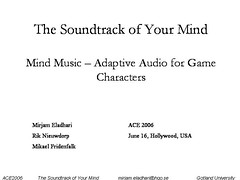I took a massive amount of pictures that I posted on Flickr.
Some of the highlights included:
Lisbeth Klastrup’s “Death Matters: Understanding Gameworld Experiences”
In her approach she surveys the actual stories that players tell about their experiences of death in virtual game worlds. For a couple of years I have, when given the chance, argued that in VGW:s there is no narrative until it is told by the one that have experienced a certain sequence of events. Before that the world consists of a vast set of elements that are the base for story construction. So while listening to Lisbeth’s speech I had a warm experience of agreement. Also she has picked a particularly fitting subject of study: “death” can be both an everydayish experience in a VGW, but also a very dramatic one, depending on the context. Lisbeth said in the speech that she found while doing her PhD work that players often told each other about these experiences, so the choice of theme for the study is not only theoretically based. In order to help advance this ongoing research, please visit the project website and tell your stories. Lisbeth is onto something important here, I also find her method of working interesting (in a good way).
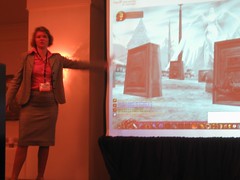
Initial Lessons From AR Façade, An Interactive Augmented Reality Drama, Steven Dow, Manish Mehta, Annie Lausier, Blair MacIntyre and Micheal Mateas.
I enjoyed this session: the team behind the paper had made Façade into an augmented reality drama, meaning that the player could move around in the staged apartment of Trip and Grace, interacting with the two virtual characters and the environment. For the more tricky AR problems that were not of the groups focus they had used OZ techniques in order to acquire results. One of the most interesting aspects was that the drama by using this became staged (association: theatre), ie that the player got the role of an actor for the other people in the room that were watching the experiment. The question the session left me was whether the experience had been a dramatic one for the player or if the novelty of the technology had had too a big impact on the experience. It will be interesting to follow how this work progresses.
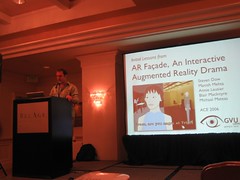
User Model in Multiplayer Mixed Reality Entertainment Applications
Stéphane Natkin and Chen Yan
Cut from the abstract:
“The goal of our research is to provide a narration model correlated to a user model in the design of mixed reality entertainment. In this paper we give a brief survey of the current researches on user model for adaptation and personalization of services and some empirical studies of user model in games and interactive narration. We propose three possible levels of the user model: generic, localized and personalized and three types of narration scheme.”
What I found most useful from their presentation was the three types of narration schemes, and the fact that they (as I perceived it) had plans of combining the three: global narration, context-oriented narration and character-based narration. And of course the mixed reality perspective made it extra interesting given my previous work with the game “Garden of Earthly Delights”.
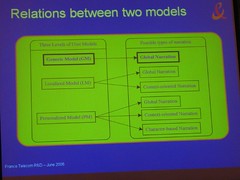
Art and Demos
Besides interesting sessions ACE2006 had organised an excellent exhibit of art work and demos. I started to dream about having a house where I had sliding interactive doors, furniture that lights the room and changes the light intensity when touched and used. The sweetest robots in the world would keep me company:



My stuff
My excuse for going to the conference was to present a short paper and poster. Elina Koivisto couldn’t make it to the conference, so I presented the poster “Paper Prototyping a Pervasive Game”:
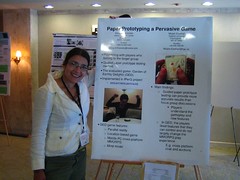
The paper I presented is called “The Soundtrack of Your Mind. Mind Music – Adaptive Audio for Game Characters”. Here are the slides.
